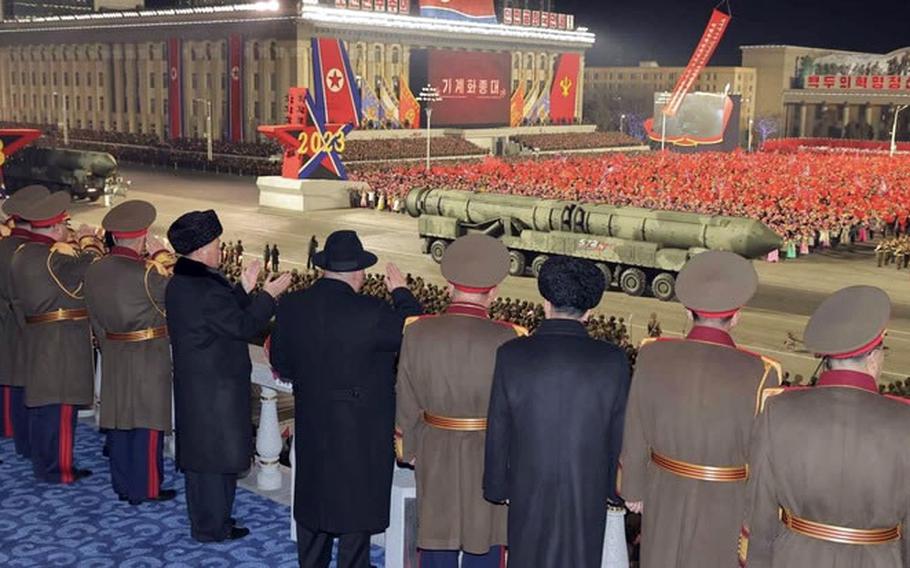
North Korea held a parade marking the 75th anniversary of its army’s founding on Wednesday, Feb. 8, 2023, in Pyongyang, where it showcased roughly 15 intercontinental ballistic missiles. (KCNA)
CAMP HUMPHREYS, South Korea — North Korean leader Kim Jong Un presided over a military parade Wednesday evening that showcased the country's largest-ever display of long-range missiles, according to images published by the state-run Korean Central News Agency.
North Korea held the event marking the 75th anniversary of its army’s founding at the main parade grounds in Pyongyang, where it showcased roughly 15 intercontinental ballistic missiles, the communist regime’s largest-ever ICBM display during a parade, defense analysts said.
At least 11 liquid-fuel Hwasong-17s were seen in photos, roughly twice the number shown at previous parades, Yang Uk, an associate research fellow at the Asan Institute for Policy Studies in Seoul, told Stars and Stripes by phone Thursday.
An analysis of the missiles is still ongoing, Yang said, adding that video footage yet to be released by North Korea was necessary to fully analyze the weapons.
Ankit Panda, a Stanton senior fellow at the Carnegie Endowment for International Peace in Washington, D.C., said on Twitter that the photos indicated "this is cumulatively more ICBM launchers than we've ever seen before at a North Korean parade."

North Korea held a parade marking the 75th anniversary of its army’s founding on Wednesday, Feb. 8, 2023, in Pyongyang, where it showcased roughly 15 intercontinental ballistic missiles. (KCNA)
North Korea claimed it last launched the Hwasong-17 in a test on Nov. 18. That missile flew eastward from North Korea’s western coast before landing in the East Sea, or Sea of Japan. Japanese officials at the time estimated that the missile had a range of 9,320 miles, within range of the continental United States.
Roughly four transporter erector launchers that appeared to carry solid-fuel canisters were also spotted in the photos, Yang said. He noted the launchers were longer than previous versions and had also undergone structural improvements that indicated North Korea was still developing its solid-fuel technology.
Solid-fuel ICBMs can be launched faster and are easier to maintain than their liquid-fuel counterparts, according to 38 North, a North Korea-monitoring organization based in Washington, D.C. Pyongyang last tested a solid-fuel engine in December as part of a “new type of strategic weapon system,” according to KCNA.
Kim was seen in photos waving as the procession of missiles rolled by on Wednesday. No mention of a speech had been relayed by KCNA as of Thursday afternoon.
The North Korean leader’s message through the photos was that the regime’s “own strategic deterrence exists,” Yang said. “That’s what Kim wants to portray to the U.S."
The parade came more than a month after Kim called for an “exponential increase” in the regime’s arms in year-end remarks carried by KCNA on Dec. 31.

North Korea held a parade marking the 75th anniversary of its army’s founding on Wednesday, Feb. 8, 2023, in Pyongyang, where it showcased roughly 15 intercontinental ballistic missiles. (KCNA)
North Korea launched roughly 75 missiles last year in 36 separate days of testing, an annual record. The regime last fired a short-range ballistic missile off its eastern coast on Jan. 1.
South Korea’s military and U.S. intelligence agencies were still analyzing the parade Thursday, the South’s Joint Chiefs of Staff said at a news briefing. South Korea's Ministry of Foreign Affairs in a news release the same day admonished Pyongyang for "wasting precious equipment on the large-scale event."
"We urge North Korea to immediately stop its illegal nuclear and missile development, reckless nuclear threats and return to denuclearization negotiations as soon as possible," the ministry said.
South Korean President Yoon Suk Yeol’s administration has vowed to respond to North Korea’s weapon tests by reinforcing Seoul’s military alliance with the U.S. and fostering relations with neighboring Japan.
Defense Secretary Lloyd Austin met with his South Korean counterpart, Lee Jong-sup, last month in Seoul, where he expressed his “unwavering commitment to maintaining peace on the Korean Peninsula,” Austin told reporters on Jan. 31.
More than 20 military drills are scheduled with the U.S. in 2023, including a tabletop exercise this month that includes a scenario addressing North Korea’s nuclear threat, according to South Korea’s defense ministry.